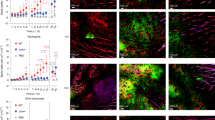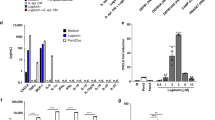Abstract
In mammals, several gene families encode peptides with antibacterial activity, such as the β-defensins and cathelicidins1,2,3. These peptides are expressed on epithelial surfaces and in neutrophils, and have been proposed to provide a first line of defence against infection by acting as ‘natural antibiotics’4,5. The protective effect of antimicrobial peptides is brought into question by observations that several of these peptides are easily inactivated6,7,8 and have diverse cellular effects that are distinct from antimicrobial activity demonstrated in vitro9,10,11,12,13. To investigate the function of a specific antimicrobial peptide in a mouse model of cutaneous infection, we applied a combined mammalian and bacterial genetic approach to the cathelicidin antimicrobial gene family14. The mature human (LL-37)15 and mouse (CRAMP)16 peptides are encoded by similar genes (CAMP and Cnlp, respectively), and have similar α-helical structures, spectra of antimicrobial activity and tissue distribution. Here we show that cathelicidins are an important native component of innate host defence in mice and provide protection against necrotic skin infection caused by Group A Streptococcus (GAS).
This is a preview of subscription content, access via your institution
Access options
Subscribe to this journal
Receive 51 print issues and online access
$199.00 per year
only $3.90 per issue
Buy this article
- Purchase on Springer Link
- Instant access to full article PDF
Prices may be subject to local taxes which are calculated during checkout




Similar content being viewed by others
References
Scott, M. G. & Hancock, R. E. Cationic antimicrobial peptides and their multifunctional role in the immune system. Crit. Rev. Immunol. 20, 407–431 (2000).
Boman, H. G. Innate immunity and the normal microflora. Immunol. Rev. 173, 5–16 (2000).
Ganz, T. & Lehrer, R. Antibiotic peptides from higher eukaryotes: biology and applications. Mol. Med. Today 5, 292–297 (1999).
Ganz, T. et al. Defensins: natural peptide antibiotics of human neutrophils. J. Clin. Invest. 76, 1427–1435 (1985).
Zasloff, M. Magainins, a class of antimicrobial peptides from Xenopus skin: Isolation, characterization of two active forms, and partial cDNA sequence of a precursor. Proc. Natl Acad. Sci. USA 84, 5449–5453 (1987).
Goldman, M. J. et al. Human β-defensin-1 is a salt-sensitive antibiotic in lung that is inactivated in cystic fibrosis. Cell 88, 553–560 (1997).
Wang, Y., Agerberth, B., Lothgren, A., Almstedt, A. & Johansson, J. Apolipoprotein A-I binds and inhibits the human antibacterial/cytotoxic peptide LL-37. J. Biol. Chem. 273, 33115–33118 (1998).
Travis, S. M. et al. Bactericidal activity of mammalian cathelicidin-derived peptides. Infect. Immun. 68, 2748–2755 (2000).
Gallo, R. L. et al. Syndecans, cell surface heparan sulfate proteoglycans, are induced by a proline-rich antimicrobial peptide from wounds. Proc. Natl Acad. Sci. USA 91, 11035–11039 (1994).
Shi, J., Ross, C., Leto, T. & Blecha, F. PR-39, a proline-rich antibacterial peptide that inhibits phagocyte NADPH oxidase activity by binding to Src homology 3 domains of p47phox. Proc. Natl Acad. Sci. USA 93, 6014–6018 (1996).
Lencer, W. et al. Induction of epithelial chloride secretion by channel-forming cryptdins 2 and 3. Proc. Natl Acad. Sci. USA 94, 8585–8589 (1997).
Risso, A., Zanetti, M. & Gennaro, R. Cytotoxicity and apoptosis mediated by two peptides of innate immunity. Cell. Immunol. 189, 107–115 (1998).
Chertov, O. et al. Identification of defensin-1, defensin-2, and CAP37/azurocidin as T-cell chemoattractant proteins released from interleukin-8-stimulated neutrophils. J. Biol. Chem. 271, 2935–2940 (1996).
Zanetti, M., Gennaro, R., Scocchi, M. & Skerlavaj, B. Structure and biology of cathelicidins. Adv. Exp. Med. Biol. 479, 203–218 (2000).
Gudmundsson, G. H. et al. The human gene Fall39 and processing of the cathelin precursor to the antibacterial peptide LL-37 in granulocytes. Eur. J. Biochem. 238, 325–332 (1996).
Gallo, R. L. et al. Identification of CRAMP, a cathelin-related antimicrobial peptide expressed in the embryonic and adult mouse. J. Biol. Chem. 272, 13088–13093 (1997).
Dorschner, R. A. et al. Cutaneous injury induces the release of cathelicidin antimicrobial peptides active against group A Streptococcus. J. Invest. Dermatol. 117, 91–97 (2001).
Ferretti, J. J. et al. Complete genome sequence of an M1 strain of Streptococcus pyogenes. Proc. Natl Acad. Sci. USA 98, 4658–4663 (2001).
Peekhaus, N. & Conway, T. Positive and negative transcriptional regulation of the Escherichia coli gluconate regulon gene gntT by GntR and the cyclic AMP (cAMP)–cAMP receptor protein complex. J. Bacteriol. 180, 1777–1785 (1998).
Miller, S. I., Pulkkinen, W. S., Selsted, M. M. & Mekalanos, J. J. Characterization of defensin resistance phenotypes associated with mutations in the phoP virulence regulon of Salmonella typhimurium. Infect. Immun. 58, 3706–3710 (1990).
Burtnick, M. N. & Woods, D. E. Isolation of polymyxin B-susceptible mutants of Burkholderia pseudomallei and molecular characterization of genetic loci involved in polymyxin B resistance. Antimicrob. Agents Chemother. 43, 2648–2656 (1999).
Cole, A. M. et al. Inhibition of neutrophil elastase prevents cathelicidin activation and impairs clearance of bacteria from wounds. Blood 97, 297–304 (2001).
Groisman, E. A., Parra-Lopez, C., Salcedo, M., Lipps, C. J. & Heffron, F. Resistance to host antimicrobial peptides is necessary for Salmonella virulence. Proc. Natl Acad. Sci. USA 89, 11939–11943 (1992).
Islam, D. et al. Downregulation of bactericidal peptides in enteric infections: A novel immune escape mechanism with bacterial DNA as a potential regulator. Nature Med. 7, 180–185 (2001).
Bals, R., Weiner, D., Meegalla, R. & Wilson, J. Transfer of a cathelicidin peptide antibiotic gene restores bacterial killing in a cystic fibrosis xenograft model. J. Clin. Invest. 103, 1113–1117 (1999).
De, Y. et al. LL-37, the neutrophil granule- and epithelial cell-derived cathelicidin, utilizes formyl peptide receptor-like 1 (FPRL1) as a receptor to chemoattract human peripheral blood neutrophils, monocytes, and T cells. J. Exp. Med. 192, 1069–1074 (2000).
Yang, D. et al. β-defensins: linking innate and adaptive immunity through dendritic and T cell CCR6. Science 286, 525–528 (1999).
Nizet, V. et al. Genetic locus for streptolysin S production by group A streptococcus. Infect. Immun. 68, 4245–4254 (2000).
Karlyshev, A. V., Pallen, M. J. & Wren, B. W. Single-primer PCR procedure for rapid identification of transposon insertion sites. Biotechniques 28, 1078–1082 (2000).
Betschel, S., Borgia, S., Barg, N., Low, D. & De Azavedo, J. Reduced virulence of group A streptococcal Tn916 mutants that do not produce streptolysin S. Infect. Immun. 66, 1671–1679 (1998).
Acknowledgements
This work was supported by grants from the NIH (R.L. G. and V. N.), a VA merit award (R.L.G.), and grants from the American Skin Association (R.L.G.) and the Rockefeller Brothers Foundation (V.N.).
Author information
Authors and Affiliations
Corresponding author
Rights and permissions
About this article
Cite this article
Nizet, V., Ohtake, T., Lauth, X. et al. Innate antimicrobial peptide protects the skin from invasive bacterial infection. Nature 414, 454–457 (2001). https://doi.org/10.1038/35106587
Received:
Accepted:
Issue Date:
DOI: https://doi.org/10.1038/35106587
This article is cited by
-
Skin Microbiome, Metabolome and Skin Phenome, from the Perspectives of Skin as an Ecosystem
Phenomics (2022)
-
Constitutive immune mechanisms: mediators of host defence and immune regulation
Nature Reviews Immunology (2021)
-
Peritoneal macrophages are impaired in cathelicidin-deficient mice systemically challenged with Escherichia coli
Cell and Tissue Research (2021)
-
Pruritus in psoriasis and atopic dermatitis: current treatments and new perspectives
Pharmacological Reports (2021)
-
The absence of murine cathelicidin-related antimicrobial peptide impacts host responses enhancing Salmonella enterica serovar Typhimurium infection
Gut Pathogens (2020)
Comments
By submitting a comment you agree to abide by our Terms and Community Guidelines. If you find something abusive or that does not comply with our terms or guidelines please flag it as inappropriate.



